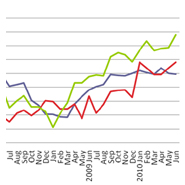Posted 05 August 2010
UCD Smurfit School and the Marketing Institute of Ireland launch Consumer Market Monitor Q2 2010 results
Consumer confidence has turned the corner according to Professor Mary Lambkin, professor of marketing in the latest edition of the Consumer Market Monitor (Q2 2010) published by UCD Michael Smurfit Graduate Business School and the Marketing Institute of Ireland. “From an all-time low of -35 at the end of 2008, with only minor improvement in 2009, consumer confidence has been recovering slowly throughout 2010 and now stands at -11. This upward trend has resulted in a positive step forward for Ireland, bringing us back into line with the European average although we still lag behind the UK.”
While the consumer confidence indicator draws on an international survey of 40,000 households across the EU, the UCD/MMI report also looks at actual spending, borrowing and saving patterns in the personal sector.
Spending
After almost a decade of continuous growth, 2009 marks the year when personal spending slumped. The decline of over 10% from the €94 billion spent in 2008 reflected a steep fall in disposable incomes and an increase in precautionary saving. However, the decline in consumer spending moderated in the final quarter of 2009 and there are signs that this positive momentum is being maintained in the first half of 2010, giving hope that he economy is beginning to stabilise. So, although consumer spending for 2010 is unlikely to return to growth, the rate of decline is now forecast at -1.5% with a return to a modest level of growth (1.1%) in 2011.
Retail sales account for 30% of consumer spending. From an overall spending peak in 2007 retail sales have stabilised this year with May 2010 volumes matching May 2009 levels. The value of sales decreased by 3.4% over the same period and the disparity between value and volume reflects the fact that prices have dropped faster than unit sales.
Tom Trainor, Chief Executive of the Marketing Institute of Ireland said, “Q2 results clearly illustrate what an enormous impact clever pricing strategies can have on consumer behaviour, one such industry that this is evident in is the car industry. Irish consumers are beginning to grow in confidence again and loosen their purse strings, which can be seen in the rise in average transaction values for retail sales.”
Breaking out the different sectors, department stores experienced an increase in sales volume of 7.6% in May 2010 compared with the same month last year but a decrease in sales value of 3.8%. Overall, retail sales for clothing, footwear and textiles show recovery in the first two quarters of 2010 prompted by a widening gap between price and volume trends. Similarly, sales volume of household equipment by up 5.6% in May 2010 while sales value remained almost static (+0.5%).
Given the relative inelasticity of food, sales in terms of value and volume held up well when the recession began to bite in 2007. However, in 2009, cross border factors contributed to a volume decline of 3.8% and a value decline of 6.3%. Comparing May 2010 with May 2009, the volume of food sales has increased by 2.5% while the value has fallen by 2.7%.
Car sales account for 20% of consumer spending and the massive decline of 62.8% in 2009 brought total sales to just under 104,000. Sales in 2010 have recovered and are 45% up on the first two quarters in 2009. Predictions for the year put totals sales at around 100,000 with the scrappage scheme accounting for around 10%.
Borrowing and saving
The personal sector credit, which is made up predominately of residential mortgages (85%), peaked in November 2008 and has been declining a consistent pace since then.
In May 2010 residential mortgage loans tumbled by €352 million, bringing the annual rate of decline to -1.8% and leaving the total amount of mortgage credit outstanding in May at €145.8 billion. This trend correlates to the level of personal saving which reached a high of 11% in 2009 and is expected to stay above 10% until 2013, but will reduce to around 8% thereafter.
The most notable change in the composition of mortgage lending has been the reduction in investment properties and the buy-to-let category has fallen from 25% in 2007 to 12%. The only category showing some buoyancy was the first time buyers who not account for 55% of the total market in value terms as they take advantage of falling prices to get on to the property ladder.
Even so, a mere 7,000 new mortgages were issued in the first quarter of 2010, at a value of €1.22 billion. Despite the recorded decline of 36.8% in new lending for quarter 1 in 2010, estate agents are expressing evidence of a pick-up in the market with a threefold increase in the number of ‘sale agreed’ second hand residential properties in January to February 2010 compared with the same period last year.
The Consumer Market Monitor uses quarterly data collected from sources including the Central Statistics Office (CSO), the Central Bank, the European Commission, and various other secondary sources. To download the full report visit http://www.mii.ie/cmm/
(Produced by UCD University Relations)

